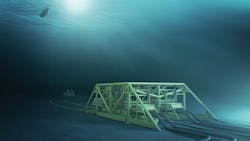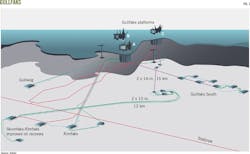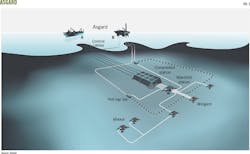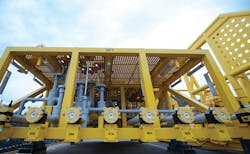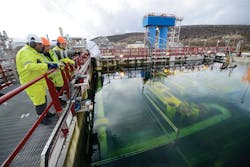Statoil operating Gullfaks, Asgard subsea compression systems
Rune Mode Ramberg
Simon Davies
Statoil
Stavanger
Statoil and its partners have brought on stream two different subsea compression systems in Gullfaks and Asgard fields offshore Norway, marking the first deployment of subsea compression technology to extend the life of gas fields and boost recovery rates.
Asgard lies on the Halten Bank in the Norwegian Sea. Statoil operates Asgard, holding 34.57% interest. Partners are Petoro, 35.69%; Eni Norge, 14.85%; Total E&P Norge, 7.68%; and ExxonMobil E&P Norway, 7.24%.
The Asgard system involves one subsea template containing two parallel compressor trains installed in 300 m of water during 2013 (Fig. 1).
As of Mar. 16, 2016, Train 1 had been in operation for 6 months and Train 2 for nearly 2 months. Regularity of the Asgard subsea system has been 97%.
Gas production from Midgard and Mikkel reservoirs is approximately 40% higher than before subsea compression started. Field life was extended for many years.
Placing a compressor closer to the well helps maximise production rates and energy efficiency. Subsea compression also requires relatively little supporting steel and operating personnel, giving it a low physical footprint compared with compression done on a platform. Statoil is considering the use of this technology on its other properties, both in Norway and elsewhere.
The Gullfaks and Asgard subsea compression projects are separate, standalone projects, and each has its own business model. To ensure best practices, Statoil deployed both using a common project management team and experts.
Two systems installed
Statoil installed subsea wet gas compression on Gullfaks
South to help maintain gas production (Fig. 2). Gullfaks South is a satellite field linked to the Gullfaks C platform. Gas is compressed in 135 m of water, raising pressure in the pipelines and accelerating gas flow to the platform.
The Gullfaks system provides a multiphase compression model for smaller fields, where simplicity and relatively low-boost pressure drive investment decisions. Statoil operates Gullfaks with 70% interest, and Petoro holds 30%.
In field-life extension efforts on Gullfaks, Statoil worked with OneSubsea and other suppliers to qualify a helico-axial multiphase compressor technology. Following successful onshore compressor testing in 2011, Statoil and its partners selected subsea compression as the preferred concept. The main components include inlet coolers, a multiphase mixer unit, and two multiphase compressors. Three additional flowline hubs are available to tie-in future Gullfaks satellite fields.
The more sophisticated Asgard model is suited to large fields or wells with a great step-out distance requiring a larger pressure boost. Asgard's subsea system involves gas-scrubbing equipment upstream of centrifugal dry gas compressors.
At Asgard, gas needs to be boosted from the Mikkel and Midgard satellite fields to the Asgard B platform to maintain stable production rates and avoid accumulation of mono-ethylene glycol (MEG) in the flowline (Fig. 3).
Lack of available space on the topsides meant a new compression platform would have been required in the absence of subsea compression. The subsea design has two trains, each comprising a scrubber, condensate pump, and a compressor with inlet and outlet cooler.
Engineers sought a compact compressor, with motor and compressor housed in the same casing and motor cooling using the process gas. The compressor is from MAN Diesel & Turbo, integrated into a compression system by Aker Solutions.
Technology qualification
Considerable equipment performance and endurance testing was done onshore years before the subsea systems were installed and commissioned.
Asgard's component qualification program, began in 2005, involved testing nearly 50 components and systems including:
• Process modules (coolers, scrubber, pump, and compressor).
• Power system (long stepout with topsides variable-speed drive[VSD], transformers, high-voltage swivel, connection system, and umbilical-power cables).
• Control system (process, active magnetic bearings, and anti-surge).
Compressor testing for Asgard began at Statoil's K-Lab in 2008 with numerous endurance tests, including tolerance testing for liquids in the gas. During 2011-13, K-Lab was upgraded to include a shallow-water pit for testing a complete compressor module. Submerged testing of a compressor unit was successfully conducted in 2014.
K-Lab workers also tested the motor and topsides VSD, using a cable simulator to confirm electrical stability over a relatively long stepout and various operating conditions. The cable simulator also helped test the condensate pump and control system.
Statoil started its project-specific technology qualification activities in 2008, focusing on:
• Compressor design for a contra-rotating multiphase compressor and centrifugal compressor with upstream scrubber.
• Robustness of seals, bearings, and electrical insulation having contact with gas.
• Liquid tolerance and flow smoothing.
• Control systems (all-electric subsea control system on Asgard).
• Condition monitoring.
• Power systems and components (including connection systems).
• Endurance testing.
• Cooling.
Remote hot-tap technology was also qualified and successfully used for retrofitting tees into the Asgard flowlines.
Much of Asgard's critical testing and qualification work required access to natural gas and condensate at realistic flowrates, temperatures, and pressures. This occurred at Statoil's K-Lab next to the Karsto gas plant near Stavanger.
Statoil began Gullfaks' technology qualification program for an upgraded helico-axial multiphase compressor and subsea inlet-recycle cooler in May 2009. The helico-axial design was a larger version of a unit demonstrated at K-Lab in 2003.
At a purpose-built loop at OneSubsea's Bergen site, testing was done with both high-pressure hydrocarbons, including Exxol mineral oil, and to gauge endurance in a nitrogen environment. Component qualification included motor penetrators, electrical monitoring systems, vibration monitoring systems, and the control pod electronics.
Gullfaks system-integration testing occurred in July 2014, involving topsides equipment, a power umbilical simulator, a subsea transformer, and one compressor unit in a submerged pit. Stackup testing also was conducted on a loadout barge.
Subsequent system integration testing December 2014-January 2015 included a fully equipped submerged manifold station and two compressors operated both in parallel and in series.
Installation
Gullfaks marine operations and topsides modification work started in 2012, followed by system startup in second-half 2015 (Fig. 4).
Topsides modifications and final subsea construction, including tying the subsea compressor station to existing pipelines with new spools, happened during planned maintenance on Gullfaks C.
Subsea compression and its protective structure were installed May-June 2015 using the monohull crane vessel Oleg Strashnov, capable of lifting as much as 1,600 tonnes.
Normand Oceanic installed the umbilical and umbilical termination assembly in May 2015. Seven Viking's moonpool installed retrievable cooler and compressor modules in June 2015. Skandi Acergy installed tie-in spools and glass-reinforced polyster covers for the protective structure during June-July.
Asgard marine operations were a major project, done primarily during normal 2011-15 operations.
Considerable seabed preparation and flowline modification work included survey, rock-cover removal, rock dumping, pipeline-end manifold (PLEM) installation, trenching, spool installation and tie-in, riser base installation, and heavy lift. Workers completely reconfigured the flowlines from Midgard to Asgard.
Twelve vessels worked for roughly 1,600 vessel days on installation. Around 60 km (37 mi) of new pipeline was installed, together with 12 PLEM, 18 spools (involving 36 tie-ins), and one hot-tap tee.
The timeline was as follows, with the topsides modifications taking place during planned maintenance:
• Modification to the Asgard A swivel to provide high-voltage power to the umbilicals (2011).
• Hot-tap tee retrofit installation on Midgard pipeline with full gas flow (2012).
• Heavy-lift installations of subsea compressor station template and subsea compressor manifold station, plus power-control-barrier fluid module on Asgard A (2013, Fig. 3).
• Pipeline, PLEM, and roughly half of the spool installations (2013).
• Subsea transformers, umbilical termination assemblies with power cables, and power umbilical (2014).
• Asgard B fiber optic link (2014).
• Remaining spools, mono-ethylene glycol (MEG) lines, and service umbilical (2014).
• Cassette-base Frames 1 and 2 (2014-15).
• Subsea compression modules.
A specially modified construction vessel, the North Sea Giant, installed 20 modules in the compressor station, April-September 2015. Modules weighing less than 70 tonnes and measuring less than 6 × 6 × 11 m were installed using the vessel's moon pool. Installation of larger modules-including spool module inlet-antisurge coolers, scrubbers, compressors, and outlet coolers-took place over the side of the vessel, using a special handling system (SHS).
The SHS featured a 420-tonne crane and a guide-frame system to allow installation through the splash zone in waves up to 4.5 m.
North Sea Giant made nine trips to install all 20 modules. Most trips featured one large installation using the SHS and installation of smaller modules through the moon pool .
Remotely operated vehicles assisted installation when needed. Plans called for the use of guidewires, but good weather enabled the SHS work to be done without them, saving time.
Marine operations were completed without damage to the crew, environment, or equipment. Installation of the modules in the compressor station accounted for less than 5% of total vessel days.
Commissioning
Gullfaks's compressors were commissioned and started from the Gullfaks C control room, with some commissioning staff working offshore. Startup involved bringing wells on stream, flowing gas into the compressor station, and closing the bypass valve.
Asgard's offshore commissioning, started in 2013, involved the topsides module, subsea manifold template, and subsea compressor station. Functional testing of Asgard's pilot compressor unit and delivery compressors took place in a test pit built for the project at K-Lab (Fig. 5).
Aker Solutions conducted similar tests in Aberdeen for the control system and in Tranby, near Oslo, for the liquids pumps. A system integration test of the compressor trains was carried out at Egersund, Norway. All three tests occurred in 2014.
The remote operation room at Statoil's onshore Stjordal offices, rather than Asgard A or B, served as the hub for commissioning the subsea compressor station in 2015.
Onshore commissioning provided a more cost-effective and safe solution, with faster team mobilization. The need for offshore certification was minimized. Selected central control-room operators worked from onshore on the subsea projects while normal operations also continued on Asgard A and B.
Statoil's Vestbase complex in Kristiansand will play a key operational role. A spare compression train (cassette base frame and all modules) is stored there, ready for deployment if needed. An extra compressor module, built in case intervention is required, is stored at OneSubsea's complex near Bergen. In the event of intervention, the North Sea Giant remains available to Statoil. Typical intervention takes 2-3 weeks, including collecting the necessary replacement modules at Vestbase, disconnecting the module needing attention, and installing the replacement module.
Any module needing attention can be temporarily parked subsea in a dedicated wet-parking frame.
The North Sea Giant has a subsea process intervention system to manage flushing residual hydrocarbons from retrieved modules using MEG or nitrogen, as required.
Statoil expects subsea condition-monitoring systems (including temperature and vibration monitoring) to alert it to any problems before failure, helping minimize intervention and offline time.
The authors
Rune Mode Ramberg ([email protected]) is Statoil's chief engineer subsea technology and operations, having 25 years of oil and gas experience, including research, early phase development, project execution, and operations. He started with Statoil in 1997, and he currently oversees 400 subsea engineers.
Ramberg has been heavily involved in technology development and implementation on various projects, including Norne, Asgard, Ormen Lange, Tordis subsea separation, Tyrihans, and Gullfaks and Asgard subsea compression. He earned a PhD (1996) in mechanical engineering from the Norwegian University of Science and Technology, Trondheim.
Simon Davies ([email protected]) is a project manager for technology management in Statoil, with 34 years of experience in the oil and gas industry. His career has spanned research and development, technology and intellectual property management, as well as business and technology strategy. Davies has held a number of management and advisory positions in supplier and operating companies. Since joining Statoil in 2009, he has worked extensively with subsea processing and more recently technology asset management. He has a BSc in chemical engineering (1982) from Heriot-Watt University, Edinburgh.
